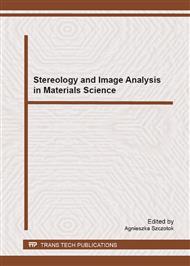p.186
p.192
p.198
p.203
p.209
p.215
p.221
p.226
p.232
Effect of Modification of Rare Earth Elements on the Morphology of Silicon Precipitates in the ZnAl22Cu3Si Alloy
Abstract:
Properties of the Zn-Al-Cu alloys can be improved by partial or total replacement of the copper with silicon. The previous studies of the current authors have shown that in alloys with silicon addition its precipitates are not evenly distributed, which can lead to uneven wear of parts made of the Zn-Al-Cu alloy. The study of phenomena occurring during the crystallization of the ZnAl22Cu3Si alloy with ATD methods have shown that silicon does not form compounds and solid solutions with Zn and Al. In the examined alloy silicon is released as the primary even before the actual solidification of dendrites. It is not possible to reduce the irregular distribution of precipitates through heat treatment. Therefore it is important to assure the uniform distribution of precipitates of silicon already on the crystallization stage, e.g. by addition of rare earth elements. The purpose of this study was to determine the effect of rare earth elements on the morphology of silicon precipitates in the ZnAl22Cu3Si alloy. The investigated material were alloys containing 22 wt% Al, 3 wt % Cu and 1.5 wt% Si (Zn-remaining). The samples have been taken from the top, middle and bottom of the ingot. In order to determine the morphological characteristics of silicon precipitates a computer program: Met-Ilo developed in the Department of Materials Science, Silesian University of Technology was used. Changes of the area fraction and shape of precipitates in particular areas of the ingot were the subject of analysis in this work.
Info:
Periodical:
Pages:
209-214
Citation:
Online since:
February 2013
Authors:
Keywords:
Price:
Сopyright:
© 2013 Trans Tech Publications Ltd. All Rights Reserved
Share:
Citation:


